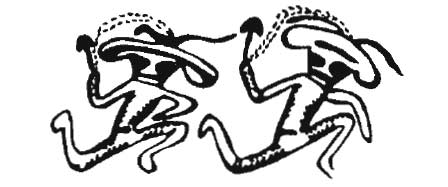[Entheogenic drugs have been used for thousands of years – as Wikipedia says. The term Paleolithic refers to human history between 2.6 million to 10,000 years ago, pretty much predating Judaism, and certainly before Christianity. It’s hardly surprising that our ancestors used drugs like that, and the images passed down to us are pretty convincing. 1 Psychoactive drugs are how they found god(s), accidentally or otherwise, and it must have been an extremely convincing experience. If that is our pre-historical experience, how has it subsequently passed into our own religions?]
 Reproduction from Tassili rock paintings.(For more information, see the article by Giorgio Samorini athttp://www.samorini.it/doc1/sam/sam-1992-sahara.pdf)
Reproduction from Tassili rock paintings.(For more information, see the article by Giorgio Samorini athttp://www.samorini.it/doc1/sam/sam-1992-sahara.pdf)“Entheogenic drugs have been used by various groups for thousands of years. There are numerous historical reports as well as modern, contemporary reports of indigenous groups using entheogens, chemical substances used in a religious, shamanic, or spiritual context.”Pasted from <https://en.wikipedia.org/wiki/Entheogenic_drugs_and_the_archaeological_record>
Old World Paleolithic:During the Paleolithic, there is ample evidence of drug use as seen by preserved botanical remains and coprolites. Some scholars had suggested that the “Flower Burial” in Shanidar Cave, a Paleolithic site in Iraq, was evidence of a shamanic death ritual, but more recent evidence and analysis has contradicted that claim. The most direct evidence we have from the Paleolithic in terms of art comes from Tassili, Algeria. From this region, there are several therianthropic images portraying the painter and the animals around him as one (an often cited effect of many hallucinatory drugs, Ego death). One image, in particular, shows a man who has formed into one common form with a mushroom.There are several Paleolithic sites that display therianthropic imagery. However, there is some debate as to whether or not sites like Lascaux or Chauvet were entheogenically inspired.World religions:There have been several reports stating that the Bible and the Vedas have several references to entheogenic drugs.Manna and mushrooms:Some researchers speculate that Manna, the food that the Israeli tribes harvest, was actually an entheogenic drug. The Bible as quoted in Exodus 16:14 reads:“And when the dew that lay was gone up, behold, upon the face of the wilderness there lay a small round thing, as small as the hoar frost on the ground. And when the children of Israel saw it, they said one to another, It is manna: for they wist not what it was. And Moses said unto them, This is the bread which the Lord hath given you to eat.”Some point to the similarities of psilocybe and the biblical description of manna as evidence.Soma:Main [Wikipedia] article: Botanical identity of Soma-HaomaIn regard to the Vedas, the religious texts of the Hindu religion, there has been speculation on the nature of what Soma, the food of the gods, actually was. In the Vedas it states:“Splendid by Law! declaring Law, truth speaking, truthful in thy works, Enouncing faith, King Soma!… O [Soma] Pavāmana, place me in that deathless, undecaying world wherein the light of heaven is set, and everlasting lustre shines…. Make me immortal in that realm where happiness and transports, where joy and felicities combine….”Amateur mycologist Robert Gordon Wasson suggested that soma is fly agaric, a mushroom commonly used by Siberian shamans, however, linguistic and ritual evidence has established that haoma was most likely a variant of Ephedra.Pasted from <https://en.wikipedia.org/wiki/Entheogenic_drugs_and_the_archaeological_record>
[The images above are from http://www.artepreistorica.com/2009/12/the-oldest-representations-of-hallucinogenic-mushrooms-in-the-world-sahara-desert-9000-%E2%80%93-7000-b-p/ an article by Giorgio Samorini]
- See for example, the images at Tassili, Algeria at http://en.psilosophy.info/the_oldest_representations_of_hallucinogenic_mushrooms_in_the_world.html [↩]

